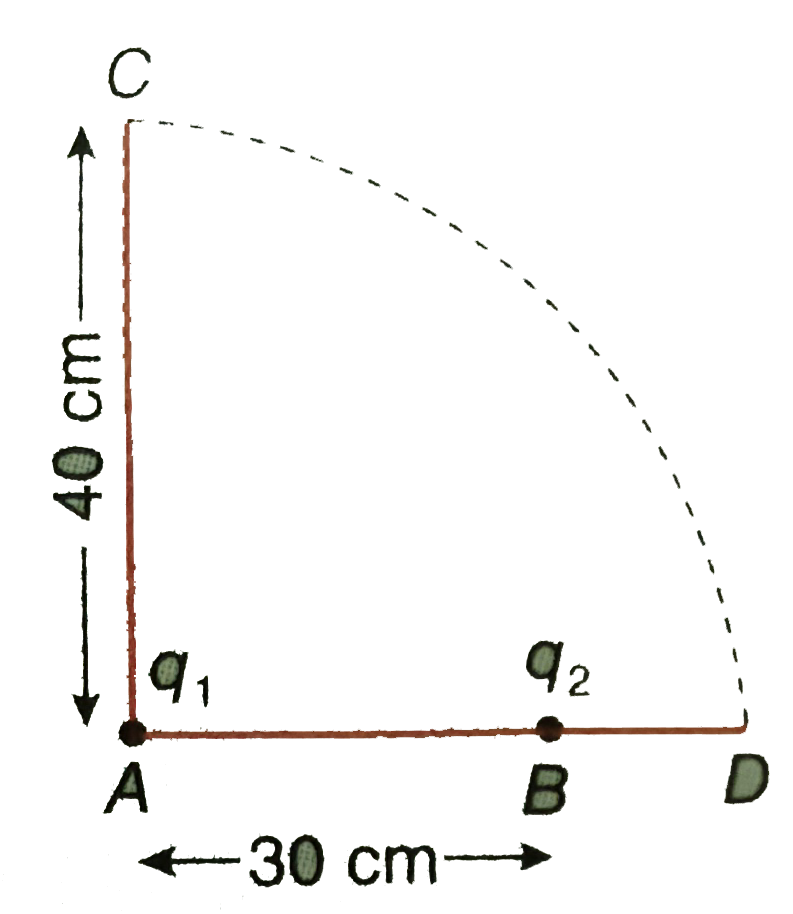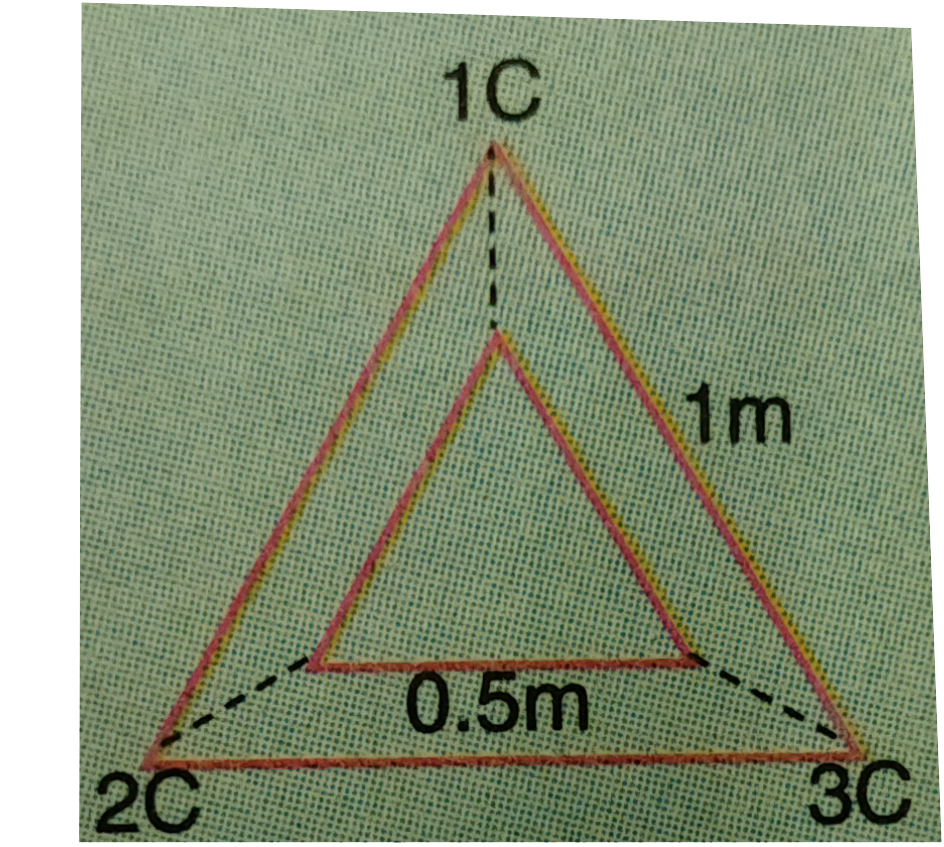Complete Solutions to Numerical Examples of chapter ELECTRIC POTENTIAL of Class 12 book with complete answers and questions
| Class 12 | PHYSICS |
| Chapter | ELECTRIC POTENTIAL |
| CHHAYA PRAKASHINI | Numerical Examples |
| Number Of Questions | 33 |
| Academic Year | 2023-24 |
A region is specified by the potential function `V = 2x^(2) + 3y^(3) - 5z^(2)`. Calculate the electric field intensity at a point (2,4,5) in this region.
View SolutionTwo point A and B are situated at distance 1 m and 2m form the source of an electrostatic field. The field at a distance x from the source is `E = (5)/(x^2)`. What is the potential difference between A and B?
View SolutionIn an electric field, the potential V(x), depending only on the x-coordinate, is given by `V(x) = ax -bx^(3)`, where a and b are constants, find out the points on the x -axis where the electric field intensity would vanish.
View SolutionTwo point charges of +49 esu and +81 esu are placed at a separation of 100 cm in air. Determine the position of the neutral point in the electric fields of the two charges. What is the electric potential at the natural point?
View SolutionAn electron is subjected to a potential difference of 180 V. Mass and charge of an electron are `9 xx 10^(-31)kg` and `1.6 xx 10^(-19)C`, respectively. Find the velocity acquired by the electron.
View SolutionAt each of the four vertices of a square of side 10 cm, four positive charges each of 20 esu are placed. Find the potential at the point of intersection of the two diagonals.
View SolutionThe distance between two points A and B in vacuum is 2d. At each of these two points a + Q charge is placed. P is the midpoint of AB. Find the intensity and potential at P due to the electric field. How will the values of these quantities change if the charge at B is replaced by a charge -Q ?
View SolutionFour point charges of +100 esu,-50 esu +20 esu and +30 esu are placed respectively at the four vertices A,B,C,D of a square of side 10 cm. Find the electric intensity and potential at the point of intersection of the diagonals.
View SolutionElectrons starting from rest and passing through a potential difference of 60 kV are found to acquire a velocity of `1.46 xx 10^(10) cm cdot s^(-1)`. Calculate the ratio of charge to the mass of an electron.
View SolutionA particle charged with `1.6 xx 10^(-19)C` is in motion. It enters the space between two parallel metal plates, parallely along the midway between them. The plates are 10 cm long and the separation between them is 2 cm. A potential difference of 300V exists between the plates. Find out the maximum velocity of the charged particle at the point of entry, for which it would be unable to emerge from the space between the plates. Given, mass of the particle = `12 xx 10^(-24) kg`.
View SolutionAn infinite number of charges, each of value q, are placed on the x-axis at the points x = 1 , x = 2, x = 4 , x = 8, ………. . Find the potential and intensity due to these charges at x = 0. If the charges are alternately positive and negative what will be the potential and intensity at the same point?
View SolutionTwo equally charged soap bubbles of equal volume are joined together to form a larger bubble . If each bubble had a potential V, find the potential of the resultant bubble.
View SolutionAn electric dipole of moment `5 xx 10^(-8)C cdot m` is placed in an electric field of magnitude `4 xx 10^(5) N cdot C^(-1)`. What amount of work is to be done to deflect it through an angle `60^(@)` ?
View SolutionFind out the maximum charge on an unearthed hollow metal sphere of radius 3.0m for which it would not discharge into air. What would be the potential of the sphere in that condition? Assume that, electric discharge into air initiates at a field intensity of `3xx10^(6)V cdot m^(-1)`.
View SolutionFind the potential at the centre of a square of side `sqrt(2)m` which carries at its four corners charges `+2 xx 10^(-9)C, +1 xx 10^(-9)C, -2 xx 10^(-9)C` and `+3 xx 10^(-9)C`.
View SolutionTwo charge `q_(1) and q_(2)` are placed 30 cm apart as shown in fig. A third charge `q_(3)` is moving along the arc of a circle of radius 40 cm from C to D. The change in the potential energy of the system is `(q^3)/(4 pi epsilon_0) k`. What is the value of k?

View SolutionTwo charges, each of `+10^(3)` esu, are placed at two points A and B separated by a distance of 200 cm. From the middle point of AB, along its perpendicular bisector, a particle having `-10^(3)` esu of charge is thrown upwards with energy `10^(4)` erg. Determine the maximum height attained by the particle. The effect of gravitation can be neglected.
View SolutionTwo point charges of values -20 esu and +20 esu are placed on the x-axis at `x = -10cm and x = +10cm` respectively. Calculate
The potentials at the middle of them
View SolutionTwo point charges of values -20 esu and +20 esu are placed on the x-axis at `x = -10cm and x = +10cm` respectively. Calculate
(ii) The electric fields at the points `P(1,10) and Q(20,0)`.
View SolutionTwo point charges of values -20 esu and +20 esu are placed on the x-axis at `x = -10cm and x = +10cm` respectively. Calculate
(iii) Find the work done in carrying a positive charge of value +6 esu from P to Q along a straight the joining them.
View SolutionTwo point charges of values -20 esu and +20 esu are placed on the x-axis at `x = -10cm and x = +10cm` respectively. Calculate
(iv) Is there any path along which the work done is less than the above value ? Why?
View SolutionTwo circular loops of radii 0.05 m and 0.09m are placed such that their axes coincide and their centres are 0.12m apart. Charge of `10^(-6)C` is spread uniformly on each loop. Find the potential difference between the centres of loops.
View SolutionThree point charges 1C, 2C and 3C are placed at the corners of an equilateral triangle of side 1m. Calculate the work required to move these charges to the corners of a smaller equilateral triangle of side 0.5 m as shown.

View SolutionA non-conducting disc of radius a with uniform positive surface charge density `sigma` is placed on the ground with its axis vertical. A particle of mass m and positive charge q is dropped along the axis of the disc from a height H with zero initial velocity. Charge per unit mass of the particle is `q/m = (4 epsilon_0 g)/(sigma)`.
(i) Find the value of H if the particle just reaches the disc.
View SolutionA non-conducting disc of radius a with uniform positive surface charge density `sigma` is placed on the ground with its axis vertical. A particle of mass m and positive charge q is dropped along the axis of the disc from a height H with zero initial velocity. Charge per unit mass of the particle is `q/m = (4 epsilon_0 g)/(sigma)`.
(ii) Find the height for its equilibrium position.
View SolutionPositive charges of magnitude 6nC, 12 nC, and 24 nC are placed at the vertices, A, B and C of a square ABCD of side 20 cm. What is the amount of work done to place a charge of 1C at vertex D?
View SolutionA proton is fired with a velocity `7.45 xx 10^(5) m//s` towards another free proton at rest. Calculate the minimum distance of approach between the protons. The mass of a proton = `1.66 xx 10^(-22) kg`.
View SolutionCharge Q is distributed between two concentric hollow sphere placed in vacuum in such a way that their surface densities of charges are equal. If the radii of the two spheres be r and R (R gt r), calculate the potential at their centre.
View SolutionCharges `+2 xx 10^(-7)C, -4 xx 10^(-7)C and +8 xx 10^(-7)C` are placed at the vertices of an equilateral triangle of side 10 cm in air. Determine the electrical potential energy of this system of charges.
View SolutionIn vacuum, three small spheres are placed on the circumference of a circle of radius r in such a way that an equilateral triangle is formed. If q be the charge on each sphere, determine the intensity of electric field and potential at the centre of the circle.
View SolutionA charged particle q is thrown with a velocity v towards another charged particle Q at rest. It approaches Q up to a closest distance r and then returns. If q is thrown with a velocity 2v, what should be the closest distance of approach?
View SolutionIn vacuum, four charges each equal to q are placed at each of the four vertices of a square. Find the intensity and potential of the electric field at the point of intersection of two diagonals.
View SolutionThree point charges q , 2q and 8q are to be placed on a 0.09m long straight line. Find the positions of the charges so that the potential energy of this system becomes minimum. In this situation, find the intensity at the position of the charge q due to the other two charges?
View Solution
Numerical Examples questions and complete solutions for chapter ELECTRIC POTENTIAL of CHHAYA PHYSICS (BENGALI ENGLISH) of Class 12
All Exercises from CHHAYA PRAKASHINI Class 12 PHYSICS ELECTRIC POTENTIAL
- CBSE Scanner
- Entrance Corner (Assertion-reason type)
- Entrance Corner (Comprehension type)
- Entrance Corner (Integer answer type)
- Entrance Corner (Multiple correct answers type)
- Examination Archive with solutions (AIPMT)
- Examination Archive with solutions (JEE Main)
- Examination Archive with solutions (NEET)
- Examination Archive with solutions (WBCHSE)
- Examination Archive with solutions (WBJEE)
- Exercise (Multiple Choice Questions - mark 1)
- Exercise (Very Short Answer Type Questions - mark 1)
- Exercise - Hots Numerical Problems (Marks 3/4/5)
- Exercise - Problem set - II (Marks 3 or 4)
- Exercise - Problem set -I (Marks 2)
- Exercise - Short Answer Type Questions - I (mark 2)
- Exercise - Short Answer Type Questions - II (mark 3 or 4)
- Higher order thinking skill (HOTS) questions
- NCERT examplar questions with answer hint (MCQ -1 single option correct)
- NCERT examplar questions with answer hint (MCQ -2 Multiple options correct)
- NCERT textbook questions with answer hint
- Numerical Examples
- Section related questions